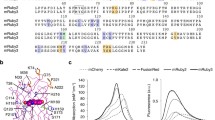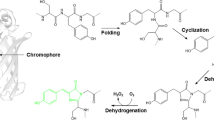Abstract
The identification and cloning of a red fluorescent protein (DsRed) obtained from Anthozoa corals has provided an alternative to commonly used green fluorescent proteins (GFPs) in bioanalytical and biomedical research. DsRed in tandem with GFPs has enhanced the feasibility of multicolor labeling studies. Properties of DsRed, for example high photostability, red-shifted fluorescence emission, and stability to pH changes have proven valuable in its use as a fluorescent tag in cell-biology applications. DsRed has some limitations, however. Its slow folding and tendency to form tetramers have been a hurdle. Several different mutational studies have been performed on DsRed to overcome these problems. In this paper, applications of DsRed in biosensing, specifically in FRET/BRET assays, whole-cell assays, and in biosensors, is discussed. In the future, construction of DsRed mutants with unique characteristics will further expand its applications in bioanalysis.






Similar content being viewed by others
References
Shaner NC, Steinbach PA, Tsien RY (2005) A guide to choosing fluorescent proteins. Nat Methods 2(12):905–909
Tsien RY (1998) The green fluorescent protein. Annu Rev Biochem 67:509–544
Prasher DC, Eckenrode VK, Ward WW, Prendergast FG, Cormier MJ (1992) Primary structure of the Aequorea victoria green-fluorescent protein. Gene 111:229–233
Matz MV, Fradkov AF, Labas YA, Savitsky AP, Zaraisky AG, Markelov ML, Lukyanov SA (1999) Fluorescent proteins from nonbioluminescent Anthozoa species. Nat Biotechnol 17:969–973
Fradkov AF, Chen Y, Ding L, Barsova EV, Matz MV, Lukyanov SA (2000) Novel fluorescent protein from Discosoma coral and its mutants possesses a unique far-red fluorescence. FEBS Lett 479(3):127–130
Verkhusha VV, Lukyanov KA (2004) The molecular properties and applications of Anthozoa fluorescent proteins and chromoproteins. Nat Biotechnol 22(3):289–296
Dove SG, Hoegh-Guldberg O, Ranganathan S (2001) Major color patterns of reef-building corals are due to a family of GFP-like proteins. Coral Reefs 19:197–204
Salih A, Hoegh-Guldberg O, Ranganathan S (2000) Fluorescent pigments in corals are photoprotective. Nature 408:850–853
Baird GS, Zacharias DA, Tsien RY (2000) Biochemistry, mutagenesis, and oligomerization of DsRed, a red fluorescent protein from coral. Proc Natl Acad Sci USA 97:11984–11989
Gross LA, Baird GS, Hoffman RC, Baldridge KK, Tsien RY (2000) The structure of the chromophore within DsRed, a red fluorescent protein from coral. Proc Natl Acad Sci USA 97:11990–11995
Yarbrough D, Wachter RM, Kallio K, Matz MV, Remington SJ (2001) Refined crystal structure of DsRed, a red fluorescent protein from coral, at 2.0-A resolution. Proc Natl Acad Sci U S A 98(2):462–467
Wiehler J, von Hummel J, Steipe B (2001) Mutants of Discosoma red fluorescent protein with a GFP-like chromophore. FEBS Lett 487:384–389
Campbell RE, Tour O, Palmer AE, Steinbach PA, Baird GS, Zacharias DA, Tsien RY (2002) A monomeric red fluorescent protein. Proc Natl Acad Sci U S A 99(12):7877–7882
Mizuno H, Sawano A, Eli P, Hama H, Miyawaki A (2001) Red fluorescent protein from Discosoma as a fusion tag and a partner for fluorescence resonance energy transfer. Biochemistry 40(8):2502–2510
Verkhusha VV, Kuznetsova IM, Stepanenko OV, Zaraisky AG, Shavlovsky, MM, Turoverov KK, Uversky VN (2003) High stability of Discosoma DsRed as compared to Aequorea EGFP. Biochemistry 42:7879–7884
Stepanenko OV, Verkhusha VV, Kazakov VI, Shavlovsky MM, Kuznetsova, IM, Uversky VN, Turoverov KK (2004) Comparative studies on the structure and stability of fluorescent proteins EGFP, zFP506, mRFP1, “dimer2”, and DsRed1. Biochemistry 43(47):14913–14923
Shaner NC, Campbell RE, Steinbach PA, Giepmans BN, Palmer AE, Tsien RY (2004) Improved monomeric red, orange and yellow fluorescent proteins derived from Discosoma sp. red fluorescent protein. Nat Biotechnol 22(12):1567–1572
Terskikh AV, Fradkov AF, Zaraisky AG, Kajava AV, Angres B (2002) Analysis of DsRed mutants. Space around the fluorophore accelerates fluorescence development. J Biol Chem 277:7633–7636
Bevis BJ, Glick BS (2002) Rapidly maturing variants of the Discosoma red fluorescent protein (DsRed). Nat Biotechnol 20:83–87
“Living Colors DsRed2” CLONTECHniques 2001, XVI(3)
“Living Colors DsRed Monomer Fluorescent Protein” CLONTECHniques 2005, XX(1)
Terskikh A, Fradkov A, Ermakova G, Zaraisky A, Tan P, Kajava AV, Zhao X, Lukyanov S, Matz M, Kim S, Weissman I, Siebert P (2000) Fluorescent timer: protein that changes color with time. Science 290(24):1585–1588
Li X, Zhao X, Fang Y, Jiang X, Duong T, Fan C, Huang CC, Kain SR (1998) Generation of destabilized green fluorescent protein as a transcription reporter. J Biol Chem 273(52):34970–34975
“Living Colors™ Destabilized DsRed Express and HcRed Vectors” CLONTECHniques 2002, XVII(4)
Lukyanov KA, Chudakov DM, Lukyanov S, Verkhusha VV (2005) Photoactivatable fluorescent proteins. Nat Rev Mol Cell Biol 6(11):885–891
Verkhusha VV, Sorkin A (2005) Conversion of the monomeric red fluorescent protein into a photoactivatable probe. Chem Biol 12(3):279–285
Zhang J, Campbell RE, Ting AY, Tsien RY (2002) Creating new fluorescent probes for cell biology. Nat Rev Mol Cell Biol 3(12):906–918
Patterson GH, Piston DW, Barisas BG (2000) Forster distances between green fluorescent protein pairs. Anal Biochem 284(2):438–440
Erickson MG, Moon DL, Yue DT (2003) DsRed as a Potential FRET Partner with CFP and GFP. Biophys J 85(1):599–611
Miyawaki A, Griesbeck O, Heim R, Tsien RY (1999) Dynamic and quantitative Ca2+ measurements using improved cameleons. Proc Natl Acad Sci U S A 96(5):2135–2140
Luo KQ, Yu VC, Pu Y, Chang DC (2001) Application of the fluorescence resonance energy transfer method for studying the dynamics of caspase-3 activation during UV-induced apoptosis in living HeLa cells. Biochem Biophys Res Commun 283(5):1054–1060
Elphick LM, Meinander A, Mikhailov A, Richard M, Toms NJ, Eriksson JE, Kass GE (2006) Live cell detection of caspase-3 activation by a Discosoma-red-fluorescent-protein-based fluorescence resonance energy transfer construct. Anal Biochem 349(1):148–155
Kohl T, Heinze KG, Kuhlemann R, Koltermann A, Schwille P (2002) A protease assay for two-photon crosscorrelation and FRET analysis based solely on fluorescent proteins. Proc Natl Acad Sci U S A 99(19):12161–12166
He L, Wu X, Simone J, Hewgill D, Lipsky PE (2005) Determination of tumor necrosis factor receptor-associated factor trimerization in living cells by CFP->YFP->mRFP FRET detected by flow cytometry. Nucleic Acids Res 33(6):1–12
Arai R, Nakagawa H, Kitayama A, Ueda H, Nagamune T (2002) Detection of protein-protein interaction by bioluminescence resonance energy transfer from firefly luciferase to red fluorescent protein. J Biosci Bioeng 94(4):362–364
Deo SK, Daunert S (2001) Green fluorescent protein mutant as label in homogeneous assays for biomolecules. Anal Biochem 289(1):52–59
Dikici EC, Deo SK, Daunert S (2003) Drug detection based on the conformational changes of calmodulin and the fluorescence of its enhanced green fluorescent protein fusion partner. Analytica Chimica Acta 500(1–2):237–245
Zhang J, Campbell RE, Ting AY, Tsien RY (2002) Creating new fluorescent probes for cell biology. 3(12):906–918
Sumner JP, Westerberg NM, Stoddard AK, Hurst TK, Cramer M, Thompson RB, Fierke CA, Kopelman R (2006) DsRed as a highly sensitive, selective, and reversible fluorescence-based biosensor for both Cu+ and Cu2+ ions. Biosens Bioelectron 21(7):1302–1308
Barondeau DP, Kassmann CJ, Tainer JA, Getzoff ED (2002) Structural chemistry of a green fluorescent protein Zn biosensor. J Am Chem Soc 124(14):3522–3524
Sumner JP, Westerberg NM, Stoddard AK, TK, Fierke CA, Kopelman R (2006) Cu+ and Cu2+-sensitive PEBBLE fluorescent nanosensors using DsRed as the recognition element. Sens Actuators B 113:760–767
Lukyanov KA, Fradkov AF, Gurskaya NG, Matz MV, Labas YA, Savitsky, AP, Markelov ML, Zaraisky AG, Zhao X, Fang Y, Tan W, Lukyanov SA (2000) Natural animal coloration can Be determined by a nonfluorescent green fluorescent protein homolog. J Biol Chem 275(34):25879–25882
Verkhusha VV, Otsuna H, Awasaki T, Oda H, Tsukita S, Ito K (2001) An enhanced mutant of red fluorescent protein DsRed for double labeling and developmental timer of neural fiber bundle formation. J Biol Chem 276:29621–29624
Mas P, Devlin PF, Panda S, Kay SA (2000) Functional interaction of phytochrome B and cryptochrome 2. Nature 408:207–211
Lauf U, Lopez P, Falk MM (2001) Expression of fluorescently tagged connexins: a novel approach to rescue function of oligomeric DsRed-tagged proteins. FEBS Lett 498:11–15
Karasawa S, Araki T, Yamamoto-Hino M, Miyawaki A (2003) A green-emitting fluorescent protein from Galaxeidae coral and its monomeric version for use in fluorescent labeling. J Biol Chem 278:34167–34171
Fradkov AF, Verkhusha VV, Staroverov DB, Bulina ME, Yanushevich YG, Martynov VI, Lukyanov S, Lukyanov KA (2002) Far-red fluorescent tag for protein labeling. Biochem J 368:17–21
Gavin P, Devenish RJ, Prescott M (2002) An approach for reducing unwanted oligomerisation of DsRed fusion proteins. Biochem Biophys Res Commun 298:707–713
Bulina ME, Verkhusha VV, Staroverov DB, Chudakov DM, Lukyanov KA (2003) Heterooligomeric tagging diminishes non-specific aggregation of target proteins fused with Anthozoa fluorescent proteins. Biochem J 371:109–114
Moede T, Leibiger B, Berggren PO, Leibiger IB (2001) Online monitoring of stimulus-induced gene expression in pancreatic beta-cells. Diabetes 50:S15–S19
Peloquin JJ, Lauzon CR, Potter S, Miller TA (2002) Transformed bacterial symbionts re-introduced to and detected in host gut. Curr Microbiol 45:41–45
Hakkila K, Maksimow M, Karp M, Virta M (2002) Reporter genes lucFF, luxCDABE, gfp, and dsred have different characteristics in whole-cell bacterial sensors. Anal Biochem 301(2):235–242
Daunert S, Barrett G, Smith-Spencer W, Shetty R, Shresta S, Feliciano J (2000) Genetically engineered whole cell sensing systems: coupling biological recognition with reporter genes. Special Chemical Sensors Issue of Chem Rev 100:2705–2738
Acknowledgement
We are grateful for American Cancer Society Indiana University Institutional Research Grant #IRG 84-002-22.
Author information
Authors and Affiliations
Corresponding author
Rights and permissions
About this article
Cite this article
Shrestha, S., Deo, S.K. Anthozoa red fluorescent protein in biosensing. Anal Bioanal Chem 386, 515–524 (2006). https://doi.org/10.1007/s00216-006-0652-6
Received:
Revised:
Accepted:
Published:
Issue Date:
DOI: https://doi.org/10.1007/s00216-006-0652-6




